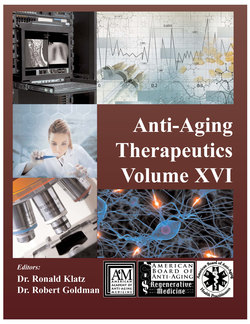Читать книгу Anti-Aging Therapeutics Volume XVI - A4M American Academy - Страница 8
На сайте Литреса книга снята с продажи.
The Biotech Factor
ОглавлениеToday, we can detect, forestall, and prevent most forms of cardiovascular incidents, cancer, diabetes, and Alzheimer’s Disease. Therapies to reverse such life-robbing conditions are on the horizon, thanks to biomedical and biotech R&D.
Medical knowledge doubles every three years. By 2017, we will know twice as much as we do today, by 2020 four-times, and so on. We submit that 2029 signals the arrival of the Biotech Singularity, when advancements in anti-aging and regenerative medicine reach maturity:
•Stem cell therapeutics, technologies aiming to beneficially alter the very basic cellular sources of dysfunctions, disorders, disabilities, and diseases
•Therapeutic cloning, technologies to develop ample sources of human cells, tissues, and organs for use in acute emergency care as well as the treatment of chronic, debilitating diseases
•Genetic engineering and genomics, advancements that permit the identification and alteration of genetics to ameliorate dysfunctions, disorders, disabilities, and diseases
•Nanotechnology, deploying micro- and molecular-sized tools to manipulate human tissue biology for microsurgical repair on a gross level, as well as microscopic nano-biology for repair at the most basic cellular level
Today, thanks to the Pharma pipeline14 of 465 drugs “targeted on 10 chronic conditions in seniors,” most adults in developed nations enjoy lifespans of around 80 years. With progress in stem cells, DNA repair, and telomerase, by 2029 lifespans of 120 years are realistically foreseeable. As genomic medicine and artificial organ technologies advance, by 2050 to 2095 we may achieve the 150 year lifespan. Past that, machine-based human enhancements may herald living 200-plus, disease-free years.
Lab Models of Aging Intervention
A drug originally designed to suppress the immune system in organ transplant recipients, rapamycin is shown in lab models to exert life-extending properties. The University of Texas Health Science Center at San Antonio (Texas, USA) team observed15 that rapamycin increased the lifespan of male and female C57BL/6J mice by 11 to 16%, most likely by reducing the increase in the hazard for mortality.
Researchers from the Buck Institute of Aging (California, USA) successfully and markedly amplified16 the lifespan of Caenorhabditis elegans (earthworm). The team altered two genetic pathways via a “combination of mutations in daf-2 and rsks-1 [to produce] a nearly 5-fold increase in longevity that is much greater than the sum of single mutations.” The worms lived to the human equivalent of 500 years.
Scientists from the University of California/Los Angeles (UCLA; California, USA) identified17 a gene that slows the aging process through the entire body. Activating the AMPK gene induces autophagy, a cellular recycling process. When AMPK is activated in the intestine or nervous system of Drosophila (fruit flies), “we see the aging process is slowed beyond the organ system in which the gene is activated.”
Delayed aging could increase life expectancy by an additional 2.2 years, most of which would be spent in good health. Observing that: “Recent scientific advances suggest that slowing the aging process (senescence) is now a realistic goal … Yet most medical research remains focused on combating individual diseases,” Dana Goldman, from the University of Southern California (USC; California, USA), and colleagues submit18 that research to delay aging and the infirmities of old age would have better population health and economic returns, as compared to advances in individual fatal diseases such as cancer and heart disease. Using the Future Elderly Model – a microsimulation of the future health and spending of older Americans – the researchers compared optimistic "disease specific" scenarios with a hypothetical "delayed aging" scenario in terms of the scenarios' impact on longevity, disability, and major entitlement program costs. The team found that delayed aging could increase life expectancy by an additional 2.2 years, most of which would be spent in good health, with the economic value of delayed aging estimated to be $7.1 trillion over fifty years. The study authors that: “Overall, greater investment in research to delay aging appears to be a highly efficient way to forestall disease, extend healthy life, and improve public health.”
